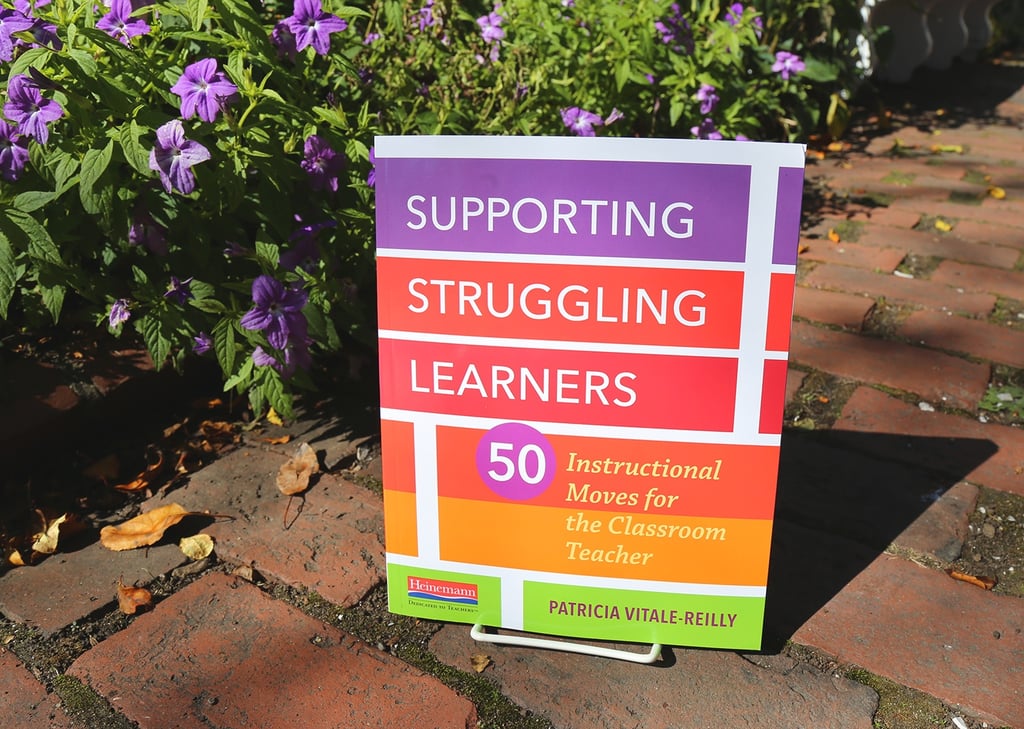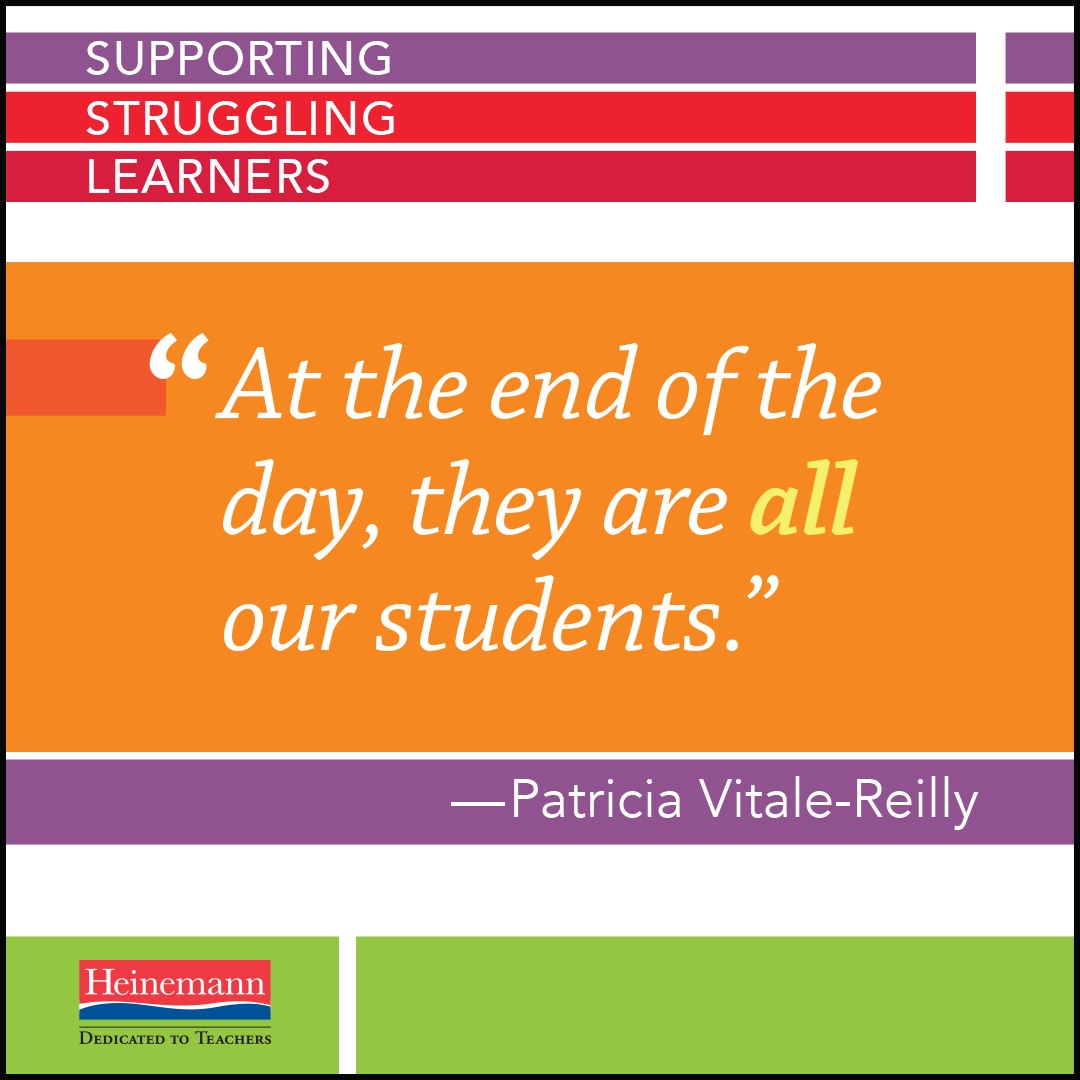The following is adapted from the introduction to Supporting Struggling Learners: 50 Instructional Moves for the Classroom Teacher by Patricia Vitale-Reilly
I have been thinking of writing about struggling learners for many years and for many reasons. I’m sure a tiny seed was planted even when I was a young child, and that seed began to grow as soon as I started working with children and young adults. We will (unfortunately) always have students in our classrooms who struggle. They struggle in many different ways—different in both the reasons why and the ways in which they struggle. Since each and every classroom will have struggling learners, it is helpful to define the kinds of struggling learners we might encounter in our classrooms and then plan moves to support them.
[Click here to download a sample chapter from Supporting Struggling Learners: 50 Instructional Moves for the Classroom Teacher ]
The term “struggling learners” is a widely used and incredibly broad term. When teachers and schools use the term, they do so to describe special education students mandated to receive services, students identified as struggling learners who receive mandated or nonmandated supplemental academic intervention services, and other students who receive no additional support or services as well. Let’s look carefully at what I see as the three cohorts of struggling learners.
Special Education Students
Students who qualify for special education services are struggling learners. These students have been classified as students who are to mandated to receive special education services, delivered by a certified special education teacher. The laws governing these mandates are most recently through IDEA, the Individuals with Disabilities Education Improvement Act of 2004. According to this legislation, special education is defined as “specially designed instruction, at no cost to the parents, to meet the unique needs of a child with a disability.”
To deliver specially designed instruction that will meet the unique needs of a child with a disability, it is important to determine not only the learner’s disability but, more importantly, the learner's strengths and what the learner struggles with. For example, a student may have a classification of “Specific Learning Disability,” which according to IDEA (1997) is defined as “a disorder in one or more of the basic psychological processes involved in understanding or in using language, spoken or written, that may manifest itself in the imperfect ability to listen, think, speak, read, write, spell, or to do mathematical calculations. The term includes such conditions as perceptual disabilities, brain injury, minimal brain dysfunction, dyslexia, auditory processing disorders and developmental aphasia.”
This broad statement, meant to describe the classification of “Specific Learning Disability,” is helpful in determining what classification the student will receive and, in turn, can determine pertinent services. Yet to develop specific techniques and strategies that will most effectively teach this student, it is essential to determine what specifically the student struggles with. Does this learner struggle with reading? If so, with what aspects of reading—decoding? Inferring a main or central idea? Responding to reading? Does the learner struggle with math? If so, with what aspects of math—remembering math facts and equations? Applying the correct mathematical equation to solve the problem? Understanding multistep word problems? All of the above? Identifying the specific struggles of special education students is essential for creating the most effective instructional moves you will implement for this learner.
Students Designated to Receive Mandated or Nonmandated Supplemental Instruction
Struggling learners are also those students who have been identified as needing additional support. These students are typically designated to receive support in a variety of subjects through programs titled “basic skills instruction” or “academic intervention services.” These are the students in our classrooms who do not meet the requisite benchmarks we have put forth for our students, including yearly standardized tests, local diagnostic and formative assessments, and other school-based metrics. Students who receive supplemental instruction usually do not meet the abovementioned metrics in reading and math and therefore are given additional support.
Marie Clay, innovative educator and founder of Reading Recovery has stated that, “70 percent of students will learn to read without struggle.” Approximately 10 percent of our population is identified as learning disabled. This leaves somewhere around 20 percent of our students who are typically—and, more importantly, should be—identified in this cohort of struggling learners: learners who need supplemental instruction.
Intermittent Strugglers
This last category of struggling learner is not as easy to define. These students are not mandated for special education services and typically do not fall into the cohort of students who receive ongoing, systematic supplemental support. Yet they—and potentially any student—can struggle at any time in their school career.
These struggles may be related to an incident or event in a student’s life, such as a home, personal, or social situation, that causes the learner to struggle and interferes with the typical progress he or she might make.
Other times, the struggle is contextual: There is a topic, course, or specific learning context that is challenging for the student. This is not to say the struggle is not real; it is just contextualized around a topic, moment of learning, or context that amplifies a weakness in the student’s memory, organization, time management, or other skills.
Sometimes, students just occasionally struggle. We have all had them in our classrooms; you know who they are. They are always on our radar, our “watch list,” but we know they will never qualify for services and do not need special education or supplemental services. They do, however, need instruction and support that intervenes in their learning and enables them to get past the struggle.
• • •
At the end of the day, they are all our students, and I think sometimes we forget that. We want so much for our students to be successful that we think we can find a place, a program, or a person who can help them. And those things may indeed help our struggling students in some way, but as classroom teachers, we can implement moves and make a difference in our students’ learning and in their lives. All we need to do is make some small changes.
• • •
To learn more about Supporting Struggling Learners: 50 Instructional Moves for the Classroom Teacher by Patricia Vitale-Reilly and to download a sample chapter, visit Heinemann.com.
 Patricia Vitale-Reilly is a national consultant, teacher, and author with 25 years of experience in education. Early on it became clear that her passion was to collaborate with leaders in education to develop and achieve engaging and relevant instructional practices.
Patricia Vitale-Reilly is a national consultant, teacher, and author with 25 years of experience in education. Early on it became clear that her passion was to collaborate with leaders in education to develop and achieve engaging and relevant instructional practices.
Patty taught in both public and independent schools, as well as at the graduate level, in New York and New Jersey. Patty also worked as staff developer at the Teachers College Reading and Writing Project. In this capacity, she helped school communities implement exemplary literacy instruction, and presented workshops and courses on the teaching of reading, writing, assessment, and literacy in the content areas. In 2003, Patty founded her own literacy consulting group, and currently works directly with school leaders, coaches, teachers, and students inside and outside of classrooms.
Patty is an author of Time for Kids teacher training materials and is a contributor to Write Time for Kids (TCM, 2000), co-author of The Complete Year in Reading and Writing Grade 2 (Scholastic, 2008), and the author of Engaging Every Learner: Classroom Principles, Strategies, and Tools (Heinemann, 2015).
As a national consultant, Patty is dedicated to guiding schools and districts to set and realize goals that matter most in their learning communities, and to her belief that every student has the right and the capacity to learn. Check out her blog exploring important and essential ideas about teaching and learning at http://whatmattersmostinteaching.blogspot.com.




